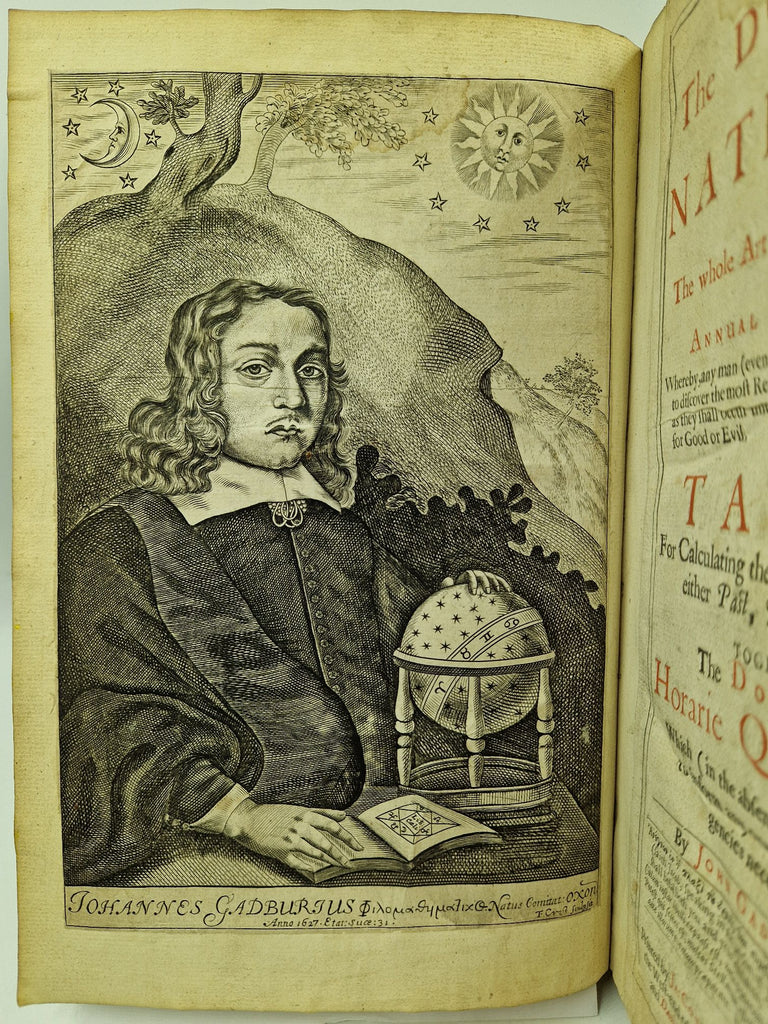GENETHLIALOGIA. Or, The Doctrine of Nativities
GADBURY, John






London: Printed by Ja. Cottrel for Giles Calverts. 1658.
First edition. Folio in 4s. pp. [18], 276; [2], 1-38 [4], 41, [2], 42-294, [10]. Lacking final blank leaf. Frontispiece portrait of Gadbury. Nineteenth century, half vellum, marbled paper covered boards. Some scuffing and rubbing to boards, label missing from spine, corners worn. Internally very good but with some browning, heavy in a few places. Overall a very good copy of one of the most important works of seventeenth century astrology.
John Gadbury (1627-1704) was quite a character. In the 1640s and 50s, he was an enthusiastic religious radical joining the Levellers and Abiezer Coppe's "Family of Love". In 1652, he began to study astrology and from 1655 published annual almanacs. As well as judicial astrology, Gadbury's other interests extended to physics, astronomy, navigation and exploration. By the late 1650s, Gadbury's political and religious affiliations were shifting and by the time of the Restoration in 1660, he had, conveniently, reinvented himself as a High Church Monarchist, declaring that the accession of Charles II to the throne was accompanied by favourable planetary portents. He was later implicated in the 1679 Popish plot. He was questioned in the presence of the King who is said to have asked him to predict which prison he would be sent to. In the event he was found innocent. More seriously, Gadbury became sensitive to criticism that astrology lacked intellectual profundity and so sought to base it in science and much of his later writing reflects this concern. Genethlialogia, however, represents something of an endpoint for Gadbury's engagement with traditional judicial astrology. It offers, in encyclopaedic detail, a guide to star signs, planetary movements, the astrological houses and their meanings and influence on a person's health, wealth, marital prospects and travel plans. In other words, the stock in trade of the everyday charlatan.
First edition. Folio in 4s. pp. [18], 276; [2], 1-38 [4], 41, [2], 42-294, [10]. Lacking final blank leaf. Frontispiece portrait of Gadbury. Nineteenth century, half vellum, marbled paper covered boards. Some scuffing and rubbing to boards, label missing from spine, corners worn. Internally very good but with some browning, heavy in a few places. Overall a very good copy of one of the most important works of seventeenth century astrology.
John Gadbury (1627-1704) was quite a character. In the 1640s and 50s, he was an enthusiastic religious radical joining the Levellers and Abiezer Coppe's "Family of Love". In 1652, he began to study astrology and from 1655 published annual almanacs. As well as judicial astrology, Gadbury's other interests extended to physics, astronomy, navigation and exploration. By the late 1650s, Gadbury's political and religious affiliations were shifting and by the time of the Restoration in 1660, he had, conveniently, reinvented himself as a High Church Monarchist, declaring that the accession of Charles II to the throne was accompanied by favourable planetary portents. He was later implicated in the 1679 Popish plot. He was questioned in the presence of the King who is said to have asked him to predict which prison he would be sent to. In the event he was found innocent. More seriously, Gadbury became sensitive to criticism that astrology lacked intellectual profundity and so sought to base it in science and much of his later writing reflects this concern. Genethlialogia, however, represents something of an endpoint for Gadbury's engagement with traditional judicial astrology. It offers, in encyclopaedic detail, a guide to star signs, planetary movements, the astrological houses and their meanings and influence on a person's health, wealth, marital prospects and travel plans. In other words, the stock in trade of the everyday charlatan.
